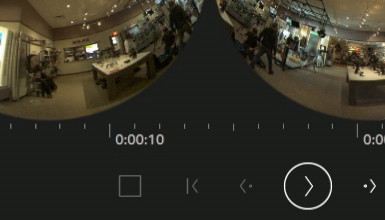Only time will tell for certain, but with all the positioning and experimentation of 2016 in the rear view mirror, 2017 is shaping up to be the year that VR content production really hits its stride.
At AbelCine, we sit in a unique position alongside the creatives, digital agencies, and brands producing VR content; we’re plugged into the companies that are not only creating the technology, but those improving the overall VR experience as well. From our vantage point, we’re beginning to see a rapid surge in brand-driven, narrative, and doc-style, non-scripted VR pieces. This VR content isn’t just aimed at the Head Mounted Display (HMD) consumer; it's also being created for dome installation experiences, mobile devices, and even television. As technology improvements in both the acquisition and display devices keep pace with this rising demand, we anticipate that more ground-breaking creators will emerge to push the genre forward.
As a company, we continually identify technical solutions that we feel work best for our clients’ creative applications, and in this regard VR is no different. What began in 2015 as an experiment in GoPro based rigs—such as the rugged, well-designed Freedom360—has now evolved into a full roster of VR technology at AbelCine.
Cinematic VR
When looking at the high-end VR market, the single-system Jaunt ONE camera stands above all others in terms of image quality, system sophistication, and general performance. Jaunt’s VR ecosystem, from camera hardware, to data management, to distribution platform, has quickly become the go-to for cinematic VR.
With highly acclaimed content–such as co-produced ABC News and ESPN projects, as well as Doug Liman’s Invisible series–available for viewing on the Jaunt distribution platform, Jaunt is carving out an ever-widening place in the ranks of high production value VR.
The Jaunt ONE camera system consists of 24 independent 1920x1200 camera modules, recording H.264 MP4 files onto 24 SD cards. Available frame rates are 25 - 120 fps. After recording, all content is prepared, organized and previewed using Jaunt Media Manager software, which also serves as an effective platform to present preview quality material to clients.
After organization, content is uploaded to the Jaunt Cloud Server for stitching and encoding. The end result is a 4K ProRes (with an 8K option coming in the future) stitched file that can integrate seamlessly into existing NLE workflows. Although the camera is always recording in stereo, the Jaunt Cloud Server offers the ability to render out a stereo (3D) or mono (2D) version of your footage. Jaunt-associated tools continue to emerge, such as plugins by Mettle, and Dashwood, to create VR-friendly edit work spaces within applications like Adobe Premiere and After Effects.
Nokia’s Rapid Evolution
When word hit in 2015 of a fully integrated VR camera system from Nokia, people were intrigued by what the former mobile phone titan had coming.
The result was OZO. With its small footprint and democratized workflow, the genius behind the OZO is the simplicity of its design and the ease of operation for its end user.
OZO incorporates eight 2K x 2K cameras, along with eight robust directional microphones. Like the Jaunt ONE, OZO is a stereo VR system, though the stereo field of view (270°) is slightly less than Jaunt's. OZO has the ability to create a full 360° image by using just the four lat/long cameras, which increases the overall quality of the final output. Four Camera Mode provides twice the amount of bandwidth available to OZO by only capturing with the four cameras around the center ring. This allows you to achieve an even greater picture quality by preserving more of the fine detail often lost in extremely challenging compression environments.
The media is a proprietary 500 GB SSD that, keeping with the camera's slick design, is housed inside the battery module. The recording format is OZORAW, which is a single file that contains all eight camera tracks and eight audio tracks, along with the metadata information the camera provides. The camera frame rate is fixed at 30 fps.
OZO Remote software, which is available on Mac and Windows, gives the user wireless control over the capabilities of the camera. Further, Nokia has been working diligently on upgrading the system’s capabilities, as well as the image quality, through ongoing firmware releases. The free software suite, which contains the Remote and Creator apps, gives the user complete control over the stitching and processing of the material. The final result is a 4K stereo or mono stitch in a variety of format options from DPX to MP4VR.
Most exciting of all, with the recent release of OZO Live Server software, Nokia has taken OZO and turned it into a fully capable live streaming solution that can slip seamlessly into an existing 4K live production ecosystem. A great, recent example was the January 2017 live stream of the Hamburg Philharmonic Concert Hall grand opening, using four OZOs and the Haivision KB 4K Encoder.
Pushing the High-Speed Envelope with Phantom VEO VR
Aside from Jaunt’s ability to shoot 120 fps, which was recently added through a firmware update, there hasn’t been a viable high-speed option in VR. That is, until now!
At AbelCine, we’ve been working on an uncompromising high-speed array-based rig solution centered around the compact Phantom VEO. The VEO VR rig consists of five cameras and has the ability to shoot at frame rates in excess of 1000 fps in full mono 360.
The cameras are frame synced and controlled via a modified AbelCine Phantom PCU box to facilitate global parameter adjustments, triggers and data offload.
It’s an exciting time for VR. If we consider that we’re essentially at the ground floor of VR technology, today’s landscape is setting the foundation for the tools that our technology partners will build tomorrow.
Experiment, inform, evolve, and push forward.
AbelCine offers VR Products for Sale and Rental, as well as VR-related events and workshops.
For a comparison of these different VR cameras, check out our VR Comparison Chart.


















